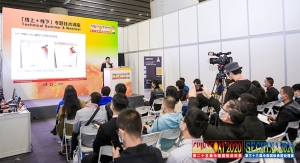05.12.17
Scientists from The Dow Chemical Company were named ‘Heroes of Chemistry’ by the American Chemical Society (ACS) this week for their rigorous commitment to helping create greener and more economical architectural paints. Through the creation of AVANSE™ Acrylic Resins and EVOQUE™ Pre-Composite Polymers from Dow Coating Materials, the brains behind the bonds recognized an opportunity to improve a market that is vital to the human condition—architecture and infrastructure—and are being acknowledged for it with this honor, bestowed by the world’s largest scientific society.
When it comes to making a positive global impact in the chemical industry, each innovation made toward raw material efficiency and product durability is notable, on a cost, service life and environmental level. For Dow’s enhanced binder platform, a polymer-pigment composite technology, the amount of titanium dioxide (TiO2) needed to support improved hiding is minimized, which not only reduces the cost of a can of paint, but lowers its environmental impact through reduced VOCs and energy consumption, while increasing its overall durability, aesthetics and performance.
“AVANSE and EVOQUE Polymers are textbook examples of Dow’s commitment to making the world a better place,” said Neil Carr, business president for Dow Coating Materials, Performance Monomers and Plastic Additives. “Behind every successful technology development is a talented team of scientists and engineers who deliver solutions to make coatings work better.”
The novel, patented chemistry forces the pigments in paints into a more ordered geometry in the wet and dried paint films, which results in improved paint performance with lower cost raw materials. In the United States alone, approximately 700 million gallons of house paint are sold each year. That paint is the first line of defense against the elements that can erode and damage homes, buildings and infrastructure, making the complex chemistry behind it all the more notable.
Both AVANSE Acrylic Binder and EVOQUE Pre-Composite Polymer Technologies have far-reaching impact due to the sheer size of the global paint market, the vital nature of paints in protecting homes and all manner of buildings and the success this polymer-pigment composite technology platform has already seen in this market. When taking into consideration the enhanced paint performance and durability aspects facilitated by the polymer-pigment composite technology, the potential to reduce coatings’ associated greenhouse gas emissions rises to 123,000 metric tons of carbon dioxide (CO2) equivalents. This amount is equivalent to the annual CO2 emissions generated from the gallons of gasoline used by approximately 14,000 cars or the amount of carbon sequestered by approximately 26,000 acres of pine forest.1
“It is not simply the breadth of knowledge our team brought to the table that made these technologies so groundbreaking,” said Sarah Eckersley, global R&D director, Dow Coating Materials, Performance Monomers and Plastics Additives. “It is their understanding that true success couples scientific insight and creativity; it is building on successful product introductions and in-depth research that has fundamentally changed paint making over the past several decades. These men and women don’t just have to know a little – they have to have a deep and comprehensive mastery of the science.”
The scientists being recognized as Heroes of Chemistry come from a variety of chemistry disciplines, including Organic, Inorganic, Analytical, Physical, Polymer, Computational and others. Dow’s scientists involved in these projects include Linda Adamson, James Bardman, Kebede Beshah, Marie Bleuzen, James Bohling, Ward Brown, Stan Brownell, Michael Clark, Beth Cooper, Steven Edwards, David Fasano, Catherine Finegan, John Hook, Melinda Keefe, Alvin Maurice, Ozzie Pressley, William Rohrbach and Wei Zhang.
Heroes will be recognized in a ceremony on Sunday, August 20, 2017, during the ACS 254th National Meeting & Exposition in Washington, D.C.
When it comes to making a positive global impact in the chemical industry, each innovation made toward raw material efficiency and product durability is notable, on a cost, service life and environmental level. For Dow’s enhanced binder platform, a polymer-pigment composite technology, the amount of titanium dioxide (TiO2) needed to support improved hiding is minimized, which not only reduces the cost of a can of paint, but lowers its environmental impact through reduced VOCs and energy consumption, while increasing its overall durability, aesthetics and performance.
“AVANSE and EVOQUE Polymers are textbook examples of Dow’s commitment to making the world a better place,” said Neil Carr, business president for Dow Coating Materials, Performance Monomers and Plastic Additives. “Behind every successful technology development is a talented team of scientists and engineers who deliver solutions to make coatings work better.”
The novel, patented chemistry forces the pigments in paints into a more ordered geometry in the wet and dried paint films, which results in improved paint performance with lower cost raw materials. In the United States alone, approximately 700 million gallons of house paint are sold each year. That paint is the first line of defense against the elements that can erode and damage homes, buildings and infrastructure, making the complex chemistry behind it all the more notable.
Both AVANSE Acrylic Binder and EVOQUE Pre-Composite Polymer Technologies have far-reaching impact due to the sheer size of the global paint market, the vital nature of paints in protecting homes and all manner of buildings and the success this polymer-pigment composite technology platform has already seen in this market. When taking into consideration the enhanced paint performance and durability aspects facilitated by the polymer-pigment composite technology, the potential to reduce coatings’ associated greenhouse gas emissions rises to 123,000 metric tons of carbon dioxide (CO2) equivalents. This amount is equivalent to the annual CO2 emissions generated from the gallons of gasoline used by approximately 14,000 cars or the amount of carbon sequestered by approximately 26,000 acres of pine forest.1
“It is not simply the breadth of knowledge our team brought to the table that made these technologies so groundbreaking,” said Sarah Eckersley, global R&D director, Dow Coating Materials, Performance Monomers and Plastics Additives. “It is their understanding that true success couples scientific insight and creativity; it is building on successful product introductions and in-depth research that has fundamentally changed paint making over the past several decades. These men and women don’t just have to know a little – they have to have a deep and comprehensive mastery of the science.”
The scientists being recognized as Heroes of Chemistry come from a variety of chemistry disciplines, including Organic, Inorganic, Analytical, Physical, Polymer, Computational and others. Dow’s scientists involved in these projects include Linda Adamson, James Bardman, Kebede Beshah, Marie Bleuzen, James Bohling, Ward Brown, Stan Brownell, Michael Clark, Beth Cooper, Steven Edwards, David Fasano, Catherine Finegan, John Hook, Melinda Keefe, Alvin Maurice, Ozzie Pressley, William Rohrbach and Wei Zhang.
Heroes will be recognized in a ceremony on Sunday, August 20, 2017, during the ACS 254th National Meeting & Exposition in Washington, D.C.






